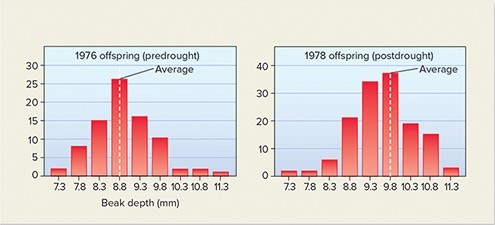Peter and Rosemary Grant study natural selection in finches on the Galápagos Islands. They have hypothesized that dry condition produce larger seeds and may result in larger beaks in succeeding generations of finches. The figure below shows their data from 1976 and 1978. The y-axis is the number of birds measured and the x-axis is the beak depth. Do their data support their hypothesis and why? 
A. No; because in 1976, before the drought, the largest beak depth was still 11.3mm.
B. Yes; because the average beak depth of birds in the population increased from 8.8mm in 1976 to 9.8mm in 1978.
C. No; more data would be necessary to show a support of their hypothesis.
D. Yes; because there were more birds measured in 1978 after the drought, therefore they must have been able to get food and reproduce.
E. No; because even though more birds were measured in 1978, the beak size of the upper range was smaller.
Answer: B
You might also like to view...
Harrison and van Buuren used ____ to reveal the molecular basis of how mycorrhizae transport phosphate
a. proteins b. mRNA c. cDNA d. cRNA e. viruses
To which of the following processes is
transpiration most analagous?
a. water moving through a water hose b. magnets attracting metal c. sucking soda through a straw d. a waterfall e. a sponge absorbing a spill
In eukaryotes, the electron transfer chain of
aerobic respiration is located
a. on the outer membrane of mitochondria. b. in the inner compartment of mitochondria. c. on the inner membrane of mitochondria. d. throughout the cytoplasm of the cell. e. in the outer compartment of mitochondria
The three functions of blood are transportation, protection, and ________
Fill in the blank(s) with correct word